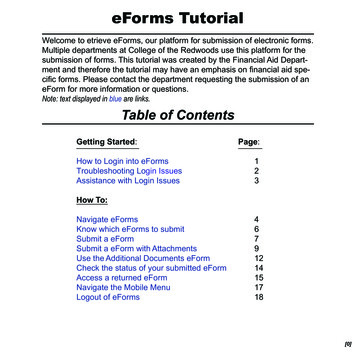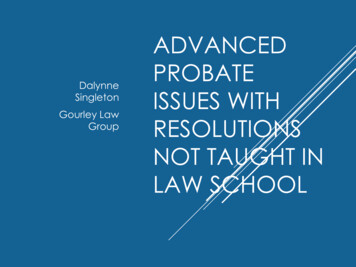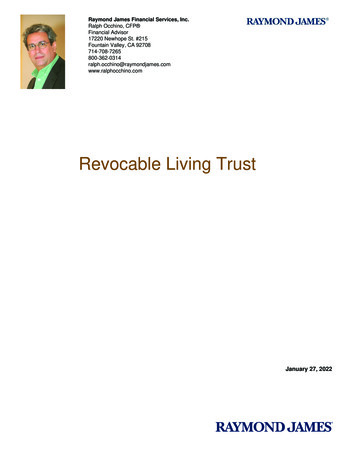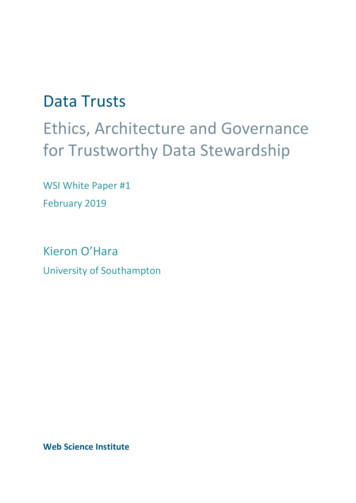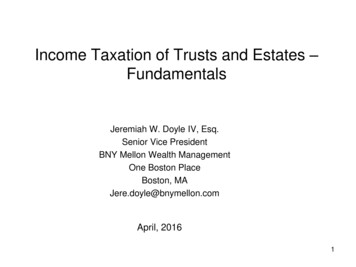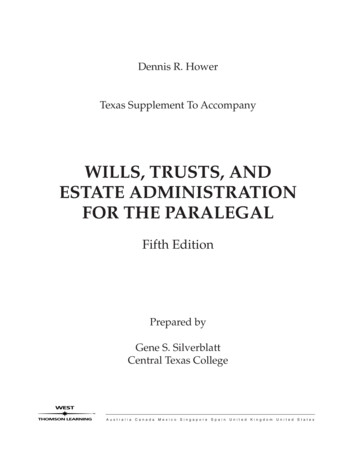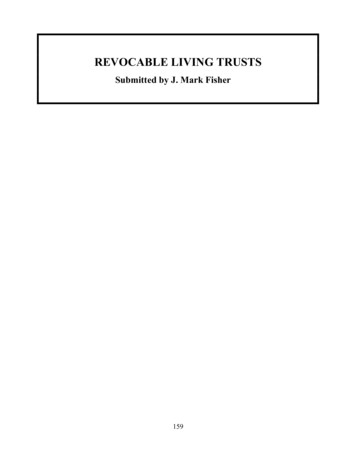
Transcription
REVOCABLE LIVING TRUSTSSubmitted by J. Mark Fisher159
160
IX.REVOCABLE LIVING TRUSTSA.Traditional Estate Planning vs. Revocable Trust Planning:IN GENERAL:Traditional estate planning, to me, includes both the option to draft either a Will or aRevocable Living Trust. I have always offered both vehicles to my clients since I began limitingmy practices to estate planning. Routinely, I will see articles titled something like, RevocableLiving Trusts, No Longer Just for the Rich. These articles discuss everything from the cost of theTrust compared to a Will, the subsequent cost of a probate, to the similarities and differences ofthe two testamentary instruments. It generally concludes by arguing a cost benefit analysis thatincludes saving both time and money when administering a Revocable Living Trust rather than aWill. What this tells me, is that the Revocable Living Trust has become the norm in many casesand with many estate planning attorneys.To truly contrast traditional estate planning and Revocable Living Trust planning, we needto define the terms. Traditional estate planning: I will submit to the notion that a traditional estateplan will consist of a client and a qualified professional, generally an attorney, sitting down anddeciding where and to whom the client wants his assets to go, upon his death. This will includethe drafting of a Will, deciding who is to get the assets titled in the client’s name only at death andwho will be the fiduciary in charge of carrying out the client’s wishes. A traditional estate plan isnot complete without a comprehensive review of all of the client’s assets. Remember, the Will isonly going to control an asset in the client’s name only at death, it will NOT control: a joint bankaccount with rights of survivorship, or made POD or TOD; a piece of property owned as jointtenants with rights of survivorship; nor a life insurance policy, IRA, 401k, with a beneficiarydesignation. As part of the traditional estate plan, each of these assets must be reviewed and161
continuously updated so the client’s intentions are carried out, and we don’t run into the case wherean unintended beneficiary receives 50% of the client’s assets at death because he forgot to updatehis life insurance beneficiary.Note that in Florida, statutes are in place to curb an unintended beneficiary if it is thedecedent’s former spouse. In 1951, Florida enacted a statute automatically cutting divorcedspouses out of each other’s Wills (currently at Fla. Stat. § 732.507(2)). In 1989, Florida enacted asimilar statute for Revocable Living Trusts (currently at Fla. Stat. § 736.1105). In addition, newFla. Stat. § 732.703 voids the designation of a former spouse as a beneficiary of an interest in anasset that will be transferred or paid upon the death of the decedent if: [1] The decedent’s marriagewas judicially dissolved or declared invalid before the decedent’s death; and [2] The designationwas made before the dissolution or order invalidating the marriage.Revocable Living Trust Planning: We want to create a plan to distribute assets of the clientto his named beneficiaries upon his death. Sound familiar? While the core principal is the same,the major difference is going to be procedural. A Trust document is going to be drafted essentiallycreating a separate legal entity. It will appoint a fiduciary to carry out the client’s wishes, and itwill also name beneficiaries to receive assets upon a certain point in the future, usually the client’sdeath. Drafting the document is step one. A comprehensive review of the client’s assets will alsoneed to take place. (See attached Asset Checklist) The end goal is to make sure the client’s assetsare either titled to the Trust or made payable to the Trust upon death. (See attached Trust FundingInstructions and Notices to Financial Institutions).Since the client generally appoints himself as Trustee during his life, there are provisionsand instructions upon the client’s incapacity. While a Power of Attorney will have similarauthority, a successor Trustee assuming title to the assets of the Trust for the benefit of the clientfor the remainder of his life is a truly seamless transition. (See attached Trustee Instructions).162
IRS TREATMENT:IRS Treatment of a Revocable Living Trust: under IRC §678(a), a Grantor (Trustor) istreated as the owner of the Trust if someone can revoke, terminate, alter, amend, appoint, or modifythe Trust and thereby re-vest title to the Trust property in the Grantor or the Grantor’s spouse. (Seealso IRC §§ 674, 677).SIMILARITIES:There are similarities between the two planning techniques that are worth noting. Mostplans involving Revocable Living Trusts also involve Wills with pour-over clauses. A Pour-OverWill generally serves as a safety-net, and if there was an asset in the client’s name only at his deathrequiring administration, the Will directs the asset to the Trust. A pour-over clause is invalidunless the recipient Trust is evidenced by written instrument. (See Sample Pour-Over Will), (SeeFla. Stat. § 732.513).The other similarity is in the manner these documents are brought into existence, orexecuted, (signed). Testamentary aspects of the Revocable Living Trust are void unless the Trustis executed with the formalities of a Will. (See Fla. Stat. § 736.0403).THE CO-TRUSTEE:A Revocable Living Trust has important planning implications during the Trustor’slifetime. The majority of the conversation has to do with the transfer of assets at death, but just asimportant is the succession of title and care of the assets upon incapacity or disability. It is routinefor a client to come in and inform the estate planner they have put one of their children on theiraccount so they can help to pay bills. The caveat here, is the client has put their child on as a coowner. As a co-owner, the child will: receive the money at death; has the right to withdraw themoney during life; and subject that money to the child’s creditors. To contrast, if we keep theaccounts titled to the Trust, we can create the same level of convenience by adding a co-Trustee.163
The co-Trustee will be a signor on the account to be able to act for the benefit of the Trustor, butthe issues of joint ownership are not present.CONTESTING THE PLAN:Both plans can be contested by a party with standing. The validity of the document willbe attacked based on lack of capacity, fraud, duress, or undue influence. There is no draftingtechnique that can be used to prevent a party from hiring an attorney and contesting the document.In fact, a provision limiting a party to contest the document is per se invalid and unenforceable.(See Fla. Stat. §§ 732.517 and 736.1108).COMMON PURPOSE OF REVOCABLE LIVING TRUST:Generally, a testator creates a Revocable Living Trust to keep the administration of theassets outside of probate. In contrast, traditional estate planning, such as a Will, is your ticket toprobate, and will govern the administration of the assets owned in the client’s name only, at death.EXAMPLE OF A TRUST PLAN NOT AVAILABLE TO A TRADITIONAL ESTATE PLAN:“Elective Share Trust” means a Trust under which the surviving spouse is entitled for lifeto the use of the property or to all of the income payable at least as often as annually; the survivingspouse has the right under the terms of the Trust or state law to require the Trustee either to makethe property productive or to convert it within a reasonable time; and, during the spouse’s life, noperson other than the spouse has the power to distribute income or principal to anyone other thanthe spouse.By drafting this Trust, you can create the source on which an elective share is payable,eliminating ongoing litigation over which asset shall be used to satisfy the share. The followingis the schedule on the factors determining what percentage of interest the spouse will have in theElective Share Trust. The value of the spouse’s interest is a percentage of the value of the principal164
of the Trust, or Trust portion, on the applicable valuation date as follows (see Fla. Stat. §732.2095):1. One hundred percent if the Trust instrument includes both a qualifying invasionpower and a qualifying power of appointment.2. Eighty percent if the Trust instrument includes a qualifying invasion power but noqualifying power of appointment.3. Fifty percent in all other cases.(See also Fla. Stat. § 732.2025).(See also the Consumer Pamphlets from the Florida Bar: Do You Have A Will?; Probate inFlorida; The Revocable Trust in Florida).B.Credit Shelter Trusts:GENERAL DEFINITION:A Credit Shelter Trust, also known as a Bypass or A/B Trust, is used to reduce or eliminatefederal estate taxes. It is generally used by married couples with estates exceeding amounts exemptfrom federal estate tax. Upon the death of the first spouse, the Credit Shelter Trust establishes aseparate, irrevocable Trust with the deceased spouse’s share of the Trust’s assets. The survivingspouse becomes the beneficiary of this Trust, with the children as beneficiaries of the remaininginterest. This irrevocable Trust is funded to the extent of the first spouse’s exemption, meaning theamount in the irrevocable Trust is not subject to estate taxes on the death of the first spouse. Ineffect, the Credit Shelter Trust takes full advantage of the first spouse’s estate tax credit.The new IRS regulations that became effective at the beginning of 2013, made the taxexemption an individual can die with, portable between a husband and wife. This new regulationhas directly impacted the necessity to draft a Trust preserving an individual’s credit for theirspouse.There are still practical reasons this type of planning is relevant. It will avoid the filing ofa 706 estate tax return on the first spouse’s death. The plan will also “lock” in the distribution ofthe Trust on at least half of the assets. This is relevant to some couples due to the fear the surviving165
spouse will remarry and completely change the established plan. While the surviving spouse willbe able to amend the Trust, the amendment will only affect the assets not titled to the deceasedspouse’s Trust.C.AMarital Deduction Trusts:MaritalDeductionTrustisa Trust inwhich transfersofpropertybetween married partners are free of federal transfer tax. A Marital Deduction Trust can take oneof two forms, either a life estate coupled with a general power of appointment given to the spouseor a Qualified Terminable Interest Property (QTIP) trust.The effect of the Marital Deduction Trust is that it shields both spouse's assets and estatesfrom federal estate taxes because when the first spouse dies, the assets indicated by the Trustor(the spouse who created the Trust) pass to the marital Trust free and clear of any and all federalestate taxes.Neither the Trustor-spouse nor the surviving spouse pay taxes on theproperty. Moreover, when the surviving spouse dies, the assets under the Trust are not includedas part of her estate, thus her federal taxes are not as high as they would have been had there notbeen a Trust.NEW IRC § 2056: A married individual can give an unlimited amount of assets, either bygift or bequest, to his or her spouse without any federal gift or estate taxes being imposed. Thisallows married couples to delay the payment of estate taxes at the passing of the first spousebecause when the surviving spouse dies, all assets in the estate over the applicable exclusionamount will be included in the survivor’s taxable estate. The unlimited marital deduction isavailable solely to surviving spouses who are citizens of the United States.166
D. Qualified Terminable Interest Trusts (QTIPs)The Q-TIP Election, commonly known as the Q-TIP Trust, is used primarily for spousesin a second marriage. Its primary purpose is to ensure that the new spouse is provided forfinancially and the children of the first marriage, if any, inherit the assets from the estate after thedeath of the new spouse.The general rule is that all property passing from one spouse to another will not besubject to any gift or estate taxes.42 This is known as the "unlimited marital deduction." Anyamount of property or assets may be transferred from one spouse to another, either while thespouses are living or at the death of one spouse with no estate or gift tax consequences for thesurviving spouse. In order for this transfer to be valid, it must be outright with no stringsattached. The rights and property transferred to your spouse cannot be what is called a"terminable interest." Terminable interest means the interest will end or fail as a result of: (1) thepassing of time, (2) the occurrence of an event or contingency, or (3) the failure of an event orcontingency to occur. There are, however, a number of exceptions to the terminable interestrule, and these are critical to the use of Trusts for transfers to your spouse, including the A/BTrust.The Q-TIP Trust Election is the most important exception to the rule denying a maritaldeduction for a property interest that may terminate. The advantage of the Q-TIP technique isthat your estate can qualify for the estate tax marital deduction without your having to givecomplete control of the ultimate disposition of your assets to your spouse. The rules are asfollows:42Florida Statute § 736.0505167
Your spouse is given a life-interest in particular property. Your spouse has a right to the income from that property payable at least annually. The property must pass from you. No person has a power to appoint any of the property to any person other than thesurviving spouse. The necessary election is made by your executor to have the property qualified.Upon the death of the surviving spouse, the entire value of the Q-TIP property is includedin the surviving spouse's gross estate. The assets will be taxed at the top marginal tax brackets.If this is not a first marriage, the use of a Q-TIP Trust can help provide financially for a currentspouse and ensure that your children from a previous marriage will be able to inherit assets.This Trust is a primary estate planning tool for people in second marriages. It preventsthe tragedy that occurs where unintended heirs inherit property and children of first marriagesand other original family members are completely disinherited. This occurs because simpletechniques for proper estate planning are not used. The following is an example of the wrongway to manage an estate:John and Mary are married for many years and have two children who are now over theage of eighteen years. John and Mary own all their property together as husband and wife. (Fig.1).168
JOHNMARYAll property jointly ownedas husband and wifeChildren of John and MaryFig. 1Mary is killed in a car accident and all jointly-owned property passes directly tothe surviving spouse, John, with no probate and no inheritance taxes due. (Fig. 2.)JOHNMARYXDies; leavesall to JohnFig. 2The surviving husband then meets and marries another woman. The new spouse, Sue,has children of her own. John, who owned all property jointly with his first wife prior to herdeath, then retitles his assets so that they now reflect the ownership of John and his new spouse,Sue, as husband and wife. (Fig. 3.)169
JOHNSUEAll propertyjointly ownedNew spouseChildren of SueFig. 3John passes away leaving a Will which directs that everything shall go to his children.Unfortunately, all the assets in the estate are now owned jointly with his second spouse, Sue.These jointly-owned assets will pass directly to Sue, nullifying John's Will with regard to theseassets, in effect disinheriting John's children. (Fig. 4.)JOHNSUEXJohn dies; allgoes to second spouseFig. 4This lack of estate planning bars the original children from inheriting altogether andallows unintended heirs to inherit the entire estate property. (Fig 5.)170
Children of Johnand Mary arecompletely disinheritedFig. 5Sue diesAll goes to childrenof second spouseIncluding the Q-TIP election as an estate planning tool will allow John, in this example,to provide financially for his new spouse without unintentionally disinheriting his children. TheQ-TIP Trust will be funded with assets John designates to be placed into the Trust. These fundswill be managed by a Trustee and all the income will pass annually to John's new spouse. Shewill have the right to invade the principal of the Trust if she needs it for emergency medicalreasons. Any assets remaining in the Trust after Sue passes away will then be distributeddirectly to John's children and will not pass to Sue's estate or her children.Using the Q-TIP election allows the twin goals of providing financially for a new spouseand satisfying the natural desire to provide for your children. The new spouse is cared for andJohn's children receive the estate assets at some point in the future instead of being left out.E. Drafting Tips and SamplesJoint Representation Agreement for Couples. When representing a married couple in theirjoint Trust, include a Joint Representation Agreement in their documents. In essence, it will statethat your firm represents the two of them together, not separately, and that confidentiality applies171
to you as a group. In other words, husband cannot ask you to change his testamentary dispositionof property and keep this information from his wife. Having the agreement in your file willprevent and protect you from any misunderstanding a client may have about their attorney-clientconfidentiality privilege. See Sample Consent Letter.Deeds. Upon creating a Living Revocable Trust, the Trustors’ initial task is funding theirTrust. As discussed previously, different types of assets require different methods for retitling theasset to the Trust. Include a checklist for your clients to ensure they do not forget an asset. Also,you can provide forms they can fill out and provide their bank, broker, etc., for retitling assets.See Sample Checklist, attached.If you are preparing deeds transferring real property into the Trust for your clients, ensureyou are preparing deeds in conformity with the state requirements, Alabama deeds require thefollowing “General Acknowledgement” rather than a general notary block:STATE OFCOUNTY OFGeneral AcknowledgmentI, , a Notary Public in and for said County, in said State, hereby certifythat John Doe, whose name is signed to the foregoing conveyance, and who is known to me, acknowledgedbefore me on this date, that, being informed of the contents of the conveyance they executed the samevoluntarily on the day the same bears date. Given under my hand and official seal on .Notary Public Signature and SealSimultaneous Death and Survival. Every Will and Trust should have a survival clauseproviding for distribution if all of the beneficiaries predeceases the testator. While it seemsunlikely, it is not far-fetched for a close family to travel together and all be killed in a caraccident together.If both Trustors should die under circumstances which render it doubtful as to whichTrustor died first, it shall be conclusively presumed that the Husband survived the Wife. If anynon-Trustor beneficiary and a Trustor should die under circumstances which would render it172
doubtful as to which died first, the Trustor or the non-Trustor beneficiary, it shall be conclusivelypresumed that said non-Trustor beneficiary predeceased such Trustor.In all other cases, a non-Trustor beneficiary shall not be deemed to have survived theTrustors or another person if he or she dies within sixty (60) days of the Trustors' death or of thedeath of such other person.Ask about the Four Generations. When meeting with a typical client, leaving everything totheir children per stirpes, ask about the clients’ parents, the clients’ children, and grandchildren.Ask questions about whether anyone has special needs, medical issues (bipolar disorder), drugabuse, tax liens, or bad marriages. These are all things to consider before leaving a large estate tosomeone.Minor Children. A client with minor children will have more issues to consider in their estateplanning. For example, who will be the guardian if both parents are gone? Who will take care ofthe money, how can it be used, and at what age can the child receive their share? Another issue isThe Florida Homestead Law. The Florida Constitution places restrictions on devising thehomestead – one simply cannot do it if survived by a minor child. Therefore, typically you wouldnot transfer a client’s homestead into their Trust if he/she has minor children.F. Common Mistakes to AvoidNot funding the Trust. A Trustor who has a complicated distribution scheme but leavescertain assets titled jointly to himself and one child, probably the successor Trustee, has ineffect, left that asset outright to the one child. The asset could be of great value, creating anunintended unequal distribution of assets. A similar mistake of Trustors having this effectinclude not changing the life insurance beneficiary to the Trust.Not having a Pour-Over Will. If as Trustor leaves an asset out of the Trust, whether onpurpose or on accident, and that asset is subject to probate, the Will controls it. If a Trustor173
has an outdated Will from years prior to creating a Trust, but did not execute a new Willleaving everything to the Trust, the older Will controls the probate and the asset will notmake it to the Trust.Having a Will with different terms. Not drafting a Pour-Over Will may keep an outdatedWill in effect, which may have different terms and different beneficiaries. Any asset left outof the Trust will have a different distribution scheme than the Trust.Not communicating with Trustees. A Trustor should at least inform the successor Trusteeof the location of the Trust agreement. The Trustor should also leave a list of his assets so thesuccessor Trustee can find them.Not planning for beneficiaries with special needs. A beneficiary with a disability or otherspecial need who relies on social programs, such as Medicaid or SSI, can become unqualifiedfor programs when he inherits substantial assets. It is important to question your clients andidentify any of these potential special needs and draft language to protect them fromdisqualifying from the programs they may rely on.Not using full legal names. Many people go by names that are not their legal names.Make sure you ask. Also, oftentimes clients forget to tell you they are a “Jr.” or a “III.” Also,if your client has gone by different names, account for it. Some clients may have a slightdifference on their social security card, state ID, which may be different from how he holdstitle to certain assets. You can cover all names with a simple “AKA paragraph,” stating thatthe Trustor is, or has been known by certain other names.Naming a Trustee not qualified to serve. Do not forget to have your clients confirmwhether their named Successor Trustees have a felony conviction.174
Naming two people to serve together. No matter how well two siblings get along, theyare going to argue when having to make important decisions together, and this can be evenworse if you have a child and new spouse serve together.Having one child in charge of another. A Trustor may have one responsible child and oneirresponsible child, and want to stretch out inheritance payments for the irresponsible one. Itis better for an aunt, uncle, or family friend to be Trustee for the irresponsible child’s share,rather than the sibling who is receiving their share all at once.175
IX. REVOCABLE LIVING TRUSTSSchedule of Attachments1. Sample Asset Checklist2. Trust Funding Instructions3. Funding, Bank & Broker Notices4. Trustee Instructions5. Pour-Over Will6. Fla. Bar Consumer Pamphlet- Do You Have a will7. Fla. Bar Consumer Pamphlet-Probate in Florida8. Fla. Bar Consumer Pamphlet-The Revocable Trust in Florida9. Sample Consent Letter176
CHECKLIST FOR TRANSFERRING CERTAIN ITEMS INTO THE TRUST1. BANK ACCOUNTS:CHECKING:All bank accounts currently owned jointly or individually should be transferred into the Trust. Takeyour Certificate of Trust and the Bank Notification to your bank and they will change your signature cards.The checks you currently use will not change.SAVINGS ACCOUNTS:All savings accounts held jointly or individually should be changed into the name of the Trust.CDs:All CDs held jointly or individually should be changed into the name of the Trust.MONEY MARKET:All money market accounts held jointly or individually should be changed into the name of theTrust.2. STOCK BROKERAGE ACCOUNTS AND STOCK CERTIFICATES:BROKERAGE ACCOUNTS:All Brokerage Accounts currently held jointly or individually should be transferred into the nameof the Trust. Use the Broker Notification found in Section 14 of your Trust book along with the Certificateof Trust, and present these documents to your Broker. He/she will change the account title into the nameof the Trust.STOCK CERTIFICATES:If you hold the Stock Certificate, you will need to contact the transfer agent where you purchasedthe certificate and request they send you the form(s) that they require to reissue the stock certificate in thename of the Trust.3. LIFE INSURANCE:Depending on the type of Trust, financial position and other circumstances, (Mark Fisher willevaluate these circumstances with you), life insurance should typically be payable first to your spouse, thento the Trustees of your Living Revocable Trust. (Example: First beneficiary: LESLIE O. SAMPLE;Second beneficiary: LESTER O. SAMPLE and LESLIE O. SAMPLE, TRUSTEES OF THESAMPLE LIVING TRUST DATED DECEMBER 9, 2014).177
4. ANNUITIES:Annuities should be payable first to your spouse, then to the Trustees of your Living RevocableTrust upon death of the annuitant. Most annuities have a designated beneficiary so that annuities will notgo through Probate. (Example: First beneficiary: LESLIE O. SAMPLE; Second beneficiary: LESTERO. SAMPLE and LESLIE O. SAMPLE, TRUSTEES OF THE SAMPLE LIVING TRUSTDATED DECEMBER 9, 2014).5. TAX DEFERRED ANNUITIES, IRAs, 401K and other TAX DEFERRED INSTRUMENTS:If the investment is a tax deferred investment where you have never paid taxes on the money placedin the investment such as an IRA or 401K Plan then these investments shall not be retitled to the name ofthe Trust. The first beneficiary listed for these investments should be the spouse. The contingent or backup beneficiary should be changed to reflect the Trust. (Example: First beneficiary: LESLIE O. SAMPLE;Second beneficiary: LESTER O. SAMPLE and LESLIE O. SAMPLE, TRUSTEES OF THESAMPLE LIVING TRUST DATED DECEMBER 9, 2014.6. REAL ESTATE:All real estate deeds (photo copy) should be given to J. Mark Fisher in order for him to create newdeeds which transfer the property from yourselves individually to yourselves as Trustees of the Trust.These deeds will be signed by you at the same time you execute your Trust documents and then will berecorded in the various counties or states where the property is located. After a period of time, usuallybetween 4 to 6 weeks for Florida Deeds, the original deeds will have been recorded in the respectivecounties and will be sent back to you for placement in Section 15 of your Trust Book. We record deeds inthe state of Florida and Alabama only. The client is responsible for recording deeds to property in all otherstates. We pay ordinary recording fees in Florida and the client is responsible for recording fees in all otherstates, including the Alabama deed tax of 1 per 1,000 on value of property conveyed.7. PERSONAL PROPERTY:Section 4 of your Trust Book contains Schedule A. Schedule A reflects all the property transferredto your Trust. The last page in Section 4 contains a statement that says "All personal property held by us(including but not limited to all personal items, jewelry and household furnishings) is transferred to ourTrust". This statement is signed by you at the time you execute the Trust documents, and it effectivelytransfers all of your personal property to your Trust without the necessity of identifying each separate itemof personal property.8. U.S. SAVING BONDS:There is a particular form (PD F 1851) which can be obtained from the Office of J. Mark Fisher orfound online at www.treasurydirect.gov/forms/sav1851.pdf. The form requests that the U.S. Governmentreissue the bond in the name of your Trust. Once the bond has been reissued, it will reflect that the bond isowned by husband and wife as Trustees of the Living Revocable Trust.178
9. PROMISSORY NOTES or MORTGAGES OWED TO YOU:All promissory notes payable to you and your spouse, or mortgages payable to you and yourspouse, shall be assigned from the two of you individually to the two of you as Trustees of your Trust. Ifyou are a single person, you will assign the promissory note or mortgage from yourself individually toyourself as Trustee of your Trust. J. Mark Fisher prepares the assignments for you that will be executed atthe time the Trust documents are signed.10. AUTOMOBILES, BOATS, and other VEHICLES:It is generally recommended that the automobile not be placed in the Trust at the time the Trustdocuments are signed. If the automobile or boat in question is extremely valuable and owned free andclear, then it should be placed in the Trust. The process of placing a motor vehicle in the Trust requires thatthe husband and wife go to the Division of Motor Vehicles, request that a new title be issued in the followingmanner: Husband and wife individually transfer the ownership to husband and wife individually andhusband and wife as Trustees of their Living Trust.As a small form of asset protection, the title to cars should not be held jointly between husbandand wife. The husband's car should be titled in his name and the wife's car should be titled in her name.If either is involved in a major accident with hundreds of thousands of dollars in damages, then only thedriver (husband or wife) will be held responsible. This may serve to protect at least 1
decedent's former spouse. In 1951, Florida enacted a statute automatically cutting divorced spouses out of each other's Wills (currently at Fla. Stat. § 732.507(2)). In 1989, Florida enacted a similar statute for Revocable Living Trusts (currently at Fla. Stat. § 736.1105). In addition, new
